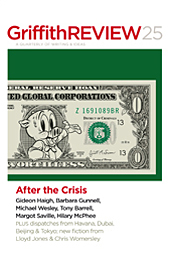Featured in

- Published 20090901
- ISBN: 9781921520761
- Extent: 264 pp
- Paperback (234 x 153mm)

Already a subscriber? Sign in here
If you are an educator or student wishing to access content for study purposes please contact us at griffithreview@griffith.edu.au
Share article
More from author

Without country
FictionTHE RIGGER COILED the line of wet rope around his hand, reeling in the sea crate they were using as a makeshift raft. 'Look...
More from this edition

A short prehistory of the future
EssayAh, the old questions, the old answers, there's nothing like them!– Samuel Beckett, Endgame Above all, the bourgeoisie produces its own gravediggers.– Karl Marx, Communist Manifesto FOR...

The story behind sister’s new villa
MemoirSTANDING IN MY in red coat, next to my luggage on the shining granite floor, I wait anxiously. Facing Gate 10, my eyes survey...

Who’s that dancing with my mother?
FictionWE WERE LIVING in Napier at the time. My father pulled the keys down from the hook in the kitchen and my mother asked...